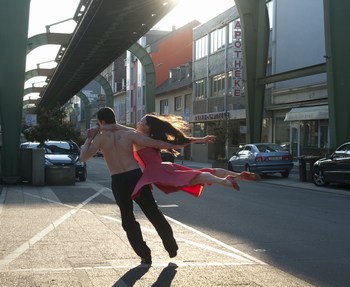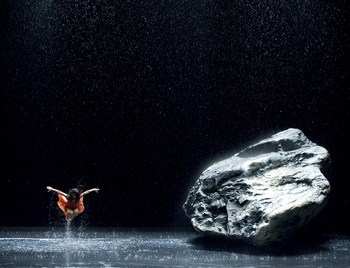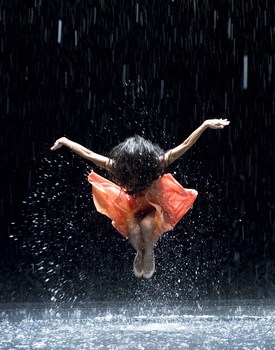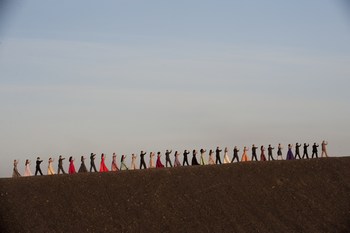|
film review PINA BAUSCH, IMMORTALIZED IN 3-D by Elizabeth Zimmer You’re a distinguished German filmmaker, award-winning documentarian Wim Wenders, and for more than 20 years you’ve been dreaming of making a 3-D movie collaboratively with Pina Bausch, Germany’s diva of contemporary dance theatre. Recently the success of a concert film about U2 convinced you that digital technology could finally let you do it right. You begin planning with her, select repertory, start experimenting. On the day you plan to show her early rushes of the film, your phone rings. The choreographer has died, only five days after being given a cancer diagnosis. 
Stunned, you shut down the production. How can you possibly proceed without her? But weeks later, at a memorial to the artist, you discover that the dancers are rehearsing several of the works you hoped to film, for what might be their final showings. You are persuaded to continue by her family, her friends, and the dancers themselves. “Once Pina was gone, we started from scratch,” you tell a radio interviewer. “The film was like a journey into the unknown.” You called it an homage to the artist.
What Wenders’ film “Pina” is really most like, in my view, is a protracted memorial service, with tributes from many company members intercut with archival footage of the choreographer herself and scenes from four of her dances, shot in 3-D. Dance fans—folks who’ve been obsessively following Bausch’s work since its first appearances in New York in 1984—are raving about the movie, and in fact Wenders’ enormous amount of technical research and experimentation pays off. The major dance elements of the film, large sections of Bausch’s “Rite of Spring,” “Café Muller,” and “Contakthof” (all from the 1970s) and the 2006 “Vollmond,” come to life in ways that dance on screen rarely does. A curtain that travels across a stage appears to be brushing my face. Parades of performers, enacting a sort of New Orleans jazz funeral march in tribute to their lost leader, march right out of the frame. 
Some of the most engaging footage was developed by another choreographer—director Wenders himself—who urged some of the 38 dancers to express their feelings for Pina in short movement sequences shot in downtown Wuppertal and in the surrounding landscape. Bringing the performers out of the theater and into natural light suddenly illuminates their personalities and her impact on them, showing us what they do when left mostly to their own devices. They gambol on traffic islands, in factory courtyards, on the edge of a municipal swimming pool, on a ridge overlooking the town. They dally on the Wuppertal Suspension Line, one of the world’s first monorails.
But “Pina,” with a running time of 103 minutes, bogs down in protracted sections of testimony by the bereaved, multi-ethnic dancers, unidentified, who stare balefully at the camera, and then tell us in their own languages, often subtitled, about their interaction with Bausch, a ballet-trained artist who pioneered the genre known as Tanztheater and has been widely imitated. 
The three-dimensional vistas of the landscapes surrounding Wuppertal are breathtaking, the German architecture commanding, but after a while the human interactions preserved in the choreography begin to pall. The dances themselves, seen so close together, underline what skeptical critics have been saying for years about her work: that it stereotypes both men and women, displaying the females in skimpy slips or formidable evening dresses, subject to violent if sometimes oblivious treatment at the hands of the men. The men are often literally burdensome to the women, and they read as adolescent boys; think of an eighth-grade dance, where sophisticated young ladies despair of finding appropriate partners among runty males who pelt them with water bombs. Neurasthenic, often hypnotic, the work focuses relentlessly on the relations between the sexes; one finds oneself longing for a wider worldview. Repetition was a key Bausch strategy; we are reminded, despite the novelty of 3-D, that times change—that time itself changes. What may have been riveting 30 years ago feels slow and turgid now.
Wenders’ finished project, which opened last year in Europe and has appeared at many festivals, is being called the world’s first 3-D art film. It had its U.S. premiere December 23 at three theaters in the New York metropolitan area, leading the box office ratings for specialty films; it will open in cities across the country on January 20 and has been shortlisted for an Oscar in the categories of best foreign language film (in fact it is spoken in nine languages, subtitled in English) and best documentary. 
Bausch, a lithe and reserved artist who studied at Juilliard, danced for Kurt Jooss and worked since 1973 directing her troupe in the industrial city of Wuppertal, died at 68 on June 30, 2009. Her company of dancers, some of whom had been with her since the beginning, performed that night. The epigraph to the movie, a quote from the chain-smoking choreographer herself, reads “Dance, dance, otherwise we are lost.”
Though its Wuppertal home theater has been closed, the troupe continues to tour, under the direction of Dominique Mercy, who’s been a member for close to 40 years, and Robert Sturm. It will appear at the Brooklyn Academy of Music in the fall of 2012.
anderbo.com fiction poetry "fact" photography masthead guidelines |